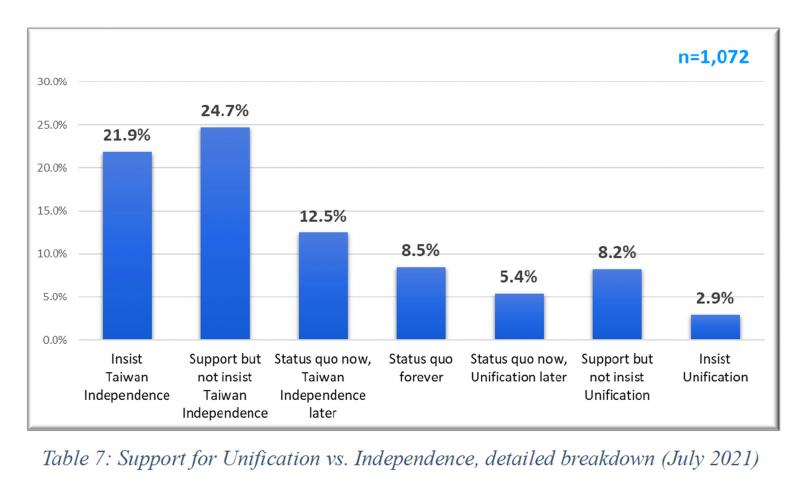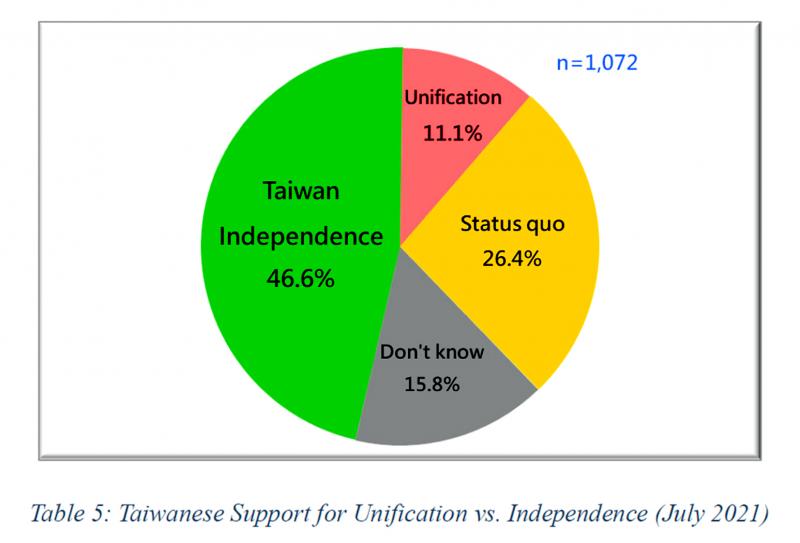Imagine if poor people were polled on why they drove beat up old cars. Imagine if that poll had several answers, which were “might want a better car if possible,” “want a better car as soon as possible,” “waiting on it” and “don’t want a better car.” Imagine if most people answered “waiting on it” and then, disregarding all other data, from that a scholar concluded that most poor people don’t want to drive a better car.
That conclusion is absurd, and yet that is one we have seen again and again in describing the preferences of Taiwanese for the final status of their country. That argument is based almost exclusively on a misleading but widely-used survey from National Chengchi University’s (NCCU) Election Study Center, “Changes in the Unification — Independence Stances of Taiwanese.”
That poll, a relic from the waning days of authoritarian power (the poll begins in 1994, the year after the repeal of the national security law that was martial law redux), was conceived by academics ensconced in a university that had been the former political warfare school of the Chinese Nationalist Party (KMT). It has the magical power of chopping the Taiwanese electorate into various groups that appear to support the status quo, thus obscuring the massive support for independence in Taiwan even in those days.

Photos courtesy of Taiwanese Public Opinion Foundation
Almost as if that were its purpose.
That poll is routinely cited by pro-Blue politicians and academics as evidence that the majority do not support independence in Taiwan (a sure signal it should never be used by anyone who cares about the truth). It is also commonly referred to by neutral media organs, which deploy it as cover: if they refer to that poll, they can avoid pointing out that the majority of people in Taiwan favor independence.
That NCCU poll thus makes it possible to claim that the Taiwanese are muddled about independence, even to claim that most don’t support it, and yet appear rational.

Photos courtesy of Taiwanese Public Opinion Foundation
Despite decades of excellent journalists being based here, few if any articles have ever forthrightly stated that Taiwanese would prefer independence. The NCCU survey has done yeoman work for China in preventing that.
The last few weeks have seen this poll appearing again in the media, a Coelacanth dragged up from the benthic deeps of bad journalism. For example, a recent Yahoo Finance piece, “Why You Should Care About Taiwan” scribed: “Generally speaking, a slight majority of Taiwanese (54.7 percent), according to an annual poll by the Taiwan’s National Chengchi University, prefer the status quo.”
After reviewing the survey’s other findings, the writer returns with: “To me all this suggests that the answer as to whether the Taiwanese consider Taiwan part of China is a definitive, ‘sort of.’”
This problem is commonplace — it also popped up on otherwise excellent Jon Oliver segment on Taiwan — and it can be solved if that poll were simply ignored into the authoritarian oblivion from whence it came.
Scores of polls conducted in the last two decades show that if Taiwanese are given the two choices of independence or “unification,” overwhelming majorities prefer independence. But in a Twitter debate on this very topic, Lev Nachman, the well-known scholar and commentator on Taiwan, dismissed these by saying: “Like, forcing a choice between two extremes is so methodologically problematic and a false portrayal of reality.”
Very well. Are there polls that interrogate the status quo? Of course. The pro-Green Taiwan Public Opinion Foundation (TPOF) has a regular poll on that topic. This August it released its latest incarnation of that survey.
Given two simple choices — independence, or “unification,”— 46 percent of Taiwanese chose independence, while 26.4 percent reported they favor the status quo, though that wasn't one of the choices offered.* Apparently, Taiwanese don’t support the status quo, as the TPOF presentation itself observed after identifying the importance of this finding: “…given the fact that both Taiwan’s pan-blue (KMT) and pan-green ([Democratic Progressive Party] DPP) administrations over the past two decades repeatedly claimed the people of Taiwan desire “maintaining status quo” forever — which clearly runs contrary to what our polls found.”
The TPOF interrogated the status quo in other ways. It asked whether people insist on Taiwan independence (21.9 percent), support but not insist on independence (24.7 percent), status quo now, independence later (12.5 percent), status quo forever (8.5 percent) and then mirrored the first three questions for the pro-China side (16.5 percent total for all three pro-China questions).
The TPOF data shows that far from preferring the status quo, the preferred outcome is independence. Furthermore, since 2006, the status quo, has never crossed 30 percent support.
The majority of people don’t support the status quo, according to TPOF data.
It should be blindingly obvious at this point, as everyone who lives here knows, that the Taiwanese favor the status quo because it is a weak form of independence and the best they can get for now, given Chinese war threats.
ETHICAL POLL?
Thus, the claim that “Taiwanese support the status quo” harnesses China’s threats of violence to help blind observers to the existence of powerful pro-independence sentiment in Taiwan. This compels the question of whether it is even ethical to cite such a poll.
Note that in each survey, the loaded term “unification” with its implication of smooth completion of something heretofore unfinished is used to describe China’s annexation of Taiwan. What would all these polls look like if “annexation” were the choice opposite “independence?”
The irony of using the authoritarian dinosaur NCCU status quo poll is that the Election Center at NCCU has another long-term data set that goes back to 2004, the Taiwan Election and Democratization Studies (TEDS) set, which asks conditional independence questions. This dataset is widely used by scholars, but never by the media. Sadly.
The first question in the TEDS set addresses whether the respondent supports independence if peace is maintained. That one generally has between 60 percent and 70 percent support. This is similar to other “conditional independence” questions in other polls.
Nor, as is often expressed in another hoary media trope, the “rising support for independence” is the demand for independence a new thing in Taiwan. Numerous scholars and journalists in the 1950s and early 1960s wrote that the Taiwanese wanted independence.
For example, Albert Axelbank, the UPI Bureau Manager on Taiwan from 1960 to 1962 observed (Harper’s Magazine, September 1963): “But responsible Formosan leaders, both Kuomintang [KMT] and opposition members, have told me that more than 90 per cent of the people desire the establishment of an independent Formosan republic.”
Peering into the future, Axelbank writes that some Formosans said that “the time will come when younger generation Formosans — and mainlanders who have become “Formosanized” — will live in harmony under a government run predominantly by Formosans.”
That time is today.
The media should consign the NCCU poll to a well-deserved oblivion and go with what the overwhelming number of polls on Taiwan show: the people of the island of Taiwan want independence, and have always wanted it.
* Due to differences in the results of the Chinese-language and English-language versions of the TPOF poll, the latter of which is cited in this column, we incorrectly stated that the TPOF gave four choices — independence, "unification," status quo and don't know — in their poll. The TPOF only gave two choices, independence and "unification," in the official Chinese-language version. The Taipei Times regrets the error.
Notes from Central Taiwan is a column written by long-term resident Michael Turton, who provides incisive commentary informed by three decades of living in and writing about his adoptive country. The views expressed here are his own.

That US assistance was a model for Taiwan’s spectacular development success was early recognized by policymakers and analysts. In a report to the US Congress for the fiscal year 1962, former President John F. Kennedy noted Taiwan’s “rapid economic growth,” was “producing a substantial net gain in living.” Kennedy had a stake in Taiwan’s achievements and the US’ official development assistance (ODA) in general: In September 1961, his entreaty to make the 1960s a “decade of development,” and an accompanying proposal for dedicated legislation to this end, had been formalized by congressional passage of the Foreign Assistance Act. Two

Despite the intense sunshine, we were hardly breaking a sweat as we cruised along the flat, dedicated bike lane, well protected from the heat by a canopy of trees. The electric assist on the bikes likely made a difference, too. Far removed from the bustle and noise of the Taichung traffic, we admired the serene rural scenery, making our way over rivers, alongside rice paddies and through pear orchards. Our route for the day covered two bike paths that connect in Fengyuan District (豐原) and are best done together. The Hou-Feng Bike Path (后豐鐵馬道) runs southward from Houli District (后里) while the

March 31 to April 6 On May 13, 1950, National Taiwan University Hospital otolaryngologist Su You-peng (蘇友鵬) was summoned to the director’s office. He thought someone had complained about him practicing the violin at night, but when he entered the room, he knew something was terribly wrong. He saw several burly men who appeared to be government secret agents, and three other resident doctors: internist Hsu Chiang (許強), dermatologist Hu Pao-chen (胡寶珍) and ophthalmologist Hu Hsin-lin (胡鑫麟). They were handcuffed, herded onto two jeeps and taken to the Secrecy Bureau (保密局) for questioning. Su was still in his doctor’s robes at

Mirror mirror on the wall, what’s the fairest Disney live-action remake of them all? Wait, mirror. Hold on a second. Maybe choosing from the likes of Alice in Wonderland (2010), Mulan (2020) and The Lion King (2019) isn’t such a good idea. Mirror, on second thought, what’s on Netflix? Even the most devoted fans would have to acknowledge that these have not been the most illustrious illustrations of Disney magic. At their best (Pete’s Dragon? Cinderella?) they breathe life into old classics that could use a little updating. At their worst, well, blue Will Smith. Given the rapacious rate of remakes in modern